Flood lights are essential lighting solutions that offer bright illumination with wide coverage. They provide safety and security by properly illuminating all dark spots. They are versatile lights for home, commercial, and industrial applications. Different types of flood lights have various features and benefits. Knowing them will help you choose the right one and satisfy your unique needs.
What are Flood Lights?
Flood lights are powerful lights used to illuminate wide areas. They are home and commercial lighting apparatuses and offer a high illumination intensity. Floodlights are also predominantly used for security and outdoor activities. They could be mounted on buildings or poles or put on stands.
Their design enables them to cast broad, uniform light, diminishing shadows and enhancing the field of vision. Flood lights are applied in sports arenas, parking lots, and building sites. They have a broad beam angle for a large area of coverage.
Types of Flood Lights
There are different types of flood lights, each with characteristic features and advantages. Knowing them will help you select the best one for your requirements.
1. Halogen Floodlights
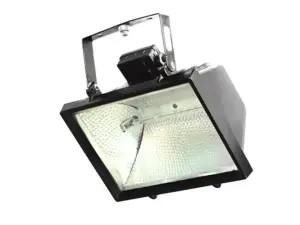
Halogen lights are another traditional type of flood light. They utilize halogen gas inside the bulb to increase brightness and efficiency. The light from these bulbs is warm and brilliant; hence, they are used where much brightness is needed. They, however, use more energy compared to their more modern counterparts. They also produce a lot of heat, which can pose a safety concern.
2. Fluorescent Floodlights
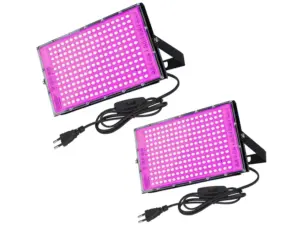
Fluorescent floodlights use fluorescent bulbs to generate light. They use less power than halogen floodlights but more than LEDs. Fluorescent lights light up brightly and uniformly and live longer than halogen bulbs. Therefore, they find applications in various areas, including commercial and industrial. However, they contain mercury that needs careful handling.
3. High-Intensity Discharge Floodlights
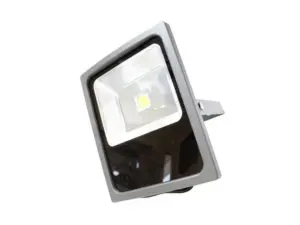
High-intensity discharge, or HID, floodlights are extremely bright. They use gas discharge technology, whereby an electric arc between tungsten electrodes creates light. HID floodlights most commonly illuminate large outdoor areas such as parking lots, stadiums, and industrial areas. They are very efficient and long-lasting. The downside is that they take time to warm up to full brightness and are more expensive to install and maintain than other types of flood lights.
4. LED Floodlights
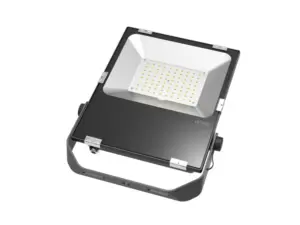
LED floodlights are popular due to their energy efficiency and extremely long life. They provide bright light with clarity since they use light-emitting diodes. They use very little power compared to halogen lights and thus can reduce their costs over a long period. LED floodlights also generate less heat, improving safety.
They are also available in a wide range of color temperatures and brightness. Therefore, they are suitable for various applications: residential security, commercial lighting, and sporting arenas.
5. Solar Flood Lights
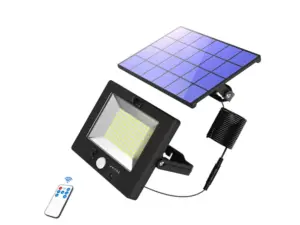
The solar flood lights are environmentally friendly and economical lighting solutions for all areas. Solar panels harness sunlight and convert it into electrical energy, providing lighting. These devices work best in remote or off-grid areas with limited access to electricity.
They are easy to install since no wiring is needed. They run on renewable energy, so there is a low operating cost. However, their effectiveness depends on the amount of sunlight. Therefore, majorly dark or shaded places may have poor performance.
6. RGB Flood Lights
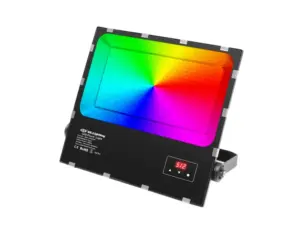
RGB floodlights allow for dynamic lighting with the addition of red, green, and blue light-emitting diodes. The mixing of colors can provide a spectrum of colors. RGB floodlights are suitable for decorative lighting, functions, and ambient visual conditions. They often feature remote controls or smartphone apps. They allow easy color changes or adjustment of other characteristics of the light. However, they are usually less bright than standard white LED floodlights.
What Are Flood Lights Used For?
Thus, floodlights have several advantages connected with them in various applications. The major benefits are:
-
Improved Visibility
They project a huge quantity of light, which assists in promoting maximum visibility for any outdoor activity. They also provide clear sightlines during sports, improving performance and enjoyment. Floodlights can also keep construction sites safe and productive at night.
-
Enhance Security
Floodlights discourage intruders by lighting up the darkest areas. Any bright area that is well-lit offers fewer chances for one to hide, thus increasing safety.
-
Energy Efficiency
More advanced floodlights, such as LED and solar-powered variants, are naturally energy-efficient. They use less power but offer high brightness. They save electricity bills while being environmentally friendly.
-
Aesthetic Enhancement
Flood lights give outstanding aesthetic appeal to landscapes and architecture by highlighting features. They also create dramatic effects and improve appearance. Strategically placed floodlights completely change the outdoors’ character.
-
Flexibility in Light Control
Most floodlights have adjustable settings for brightness level, beam angle, and activation time. This allows for flexibility in enlightening various styles to suit individual requirements.
-
Reliability
Floodlights were invented to perform consistently. Good-quality floodlights can sustain brightness and functionality over a long period. This dependability gives them an edge in meeting the most important light needs.
How to Choose the Right Flood Light for Your Applications?
Many critical factors drive a proper floodlight choice. Each one ensures great performance and suitability for your purposes.
-
Brightness and Lumens
The brightness of a floodlight is measured in lumens. More lumens correspond to a brighter light. Take an area you want to light up; the larger it is, the more lumens you need. For residential purposes, lumens can be lower. Commercial or sports areas need higher lumens for clearer lighting. Choose appropriately to have a clear vision.
-
Energy Efficiency
Energy efficiency is a vital factor in reducing electricity bills. An LED floodlight is very energy-efficient. Less power is consumed with a bright light output. Compare the energy consumption of different floodlights. Always look out for certifications and energy ratings. An energy-efficient option not only saves you money but also benefits the environment.
-
Durability and Weather Resistance
Floodlights are exposed to vigorous weather conditions. Make sure that the floodlight you choose is sturdy and water-resistant. Look out for waterproofing and strong materials. This gives it a chance at longevity and a reliable capacity to perform. Durability reduces the frequency of replacements, hence saving time and money.
-
Installation and Maintenance
Consider the ease of installation and maintenance. Some will require professional installation, while others will be user-friendly. Choose one that best suits your installation ability. Always check on the maintenance requirements. In most cases, LEDs and solar lights require minimal maintenance. Easy installation and low maintenance improve convenience.
-
Beam Angle and Coverage
The beam angle dictates the extent of the light spread. Therefore, a wide beam angle will give out light that covers a broader area. In this regard, floodlights with a wide beam angle are ideal for large spaces. On the contrary, a narrower beam angle is more effective if focused light delivery is the objective. Coverage needs, therefore, dictate the choice of beam angle. This is for perfect illumination.
-
Color Temperature
Color temperature also affects the appearance of the light. The unit of measure is Kelvin, and warm and cool temperatures are included. Warm light would be softer and more inviting, around 3000K.
The cool light is brighter and more alert; it is above 5000K. Choose according to the ambiance and functionality you want to achieve. Outdoor security lighting should be cooler in temperature.
-
Cost and Budget
Budget is essential in your purchase. Flood lights also come in very highly varied prices. However, high-end floodlights are usually equipped with advanced features at a premium price. So, set a budget for yourself. Balance the cost with what you need. Energy efficiency and durability will bring long-term savings. A well-chosen floodlight would be worth an investment.
Conclusion
Flood lights are used in modern lighting solutions. They offer high-intensity illumination for various applications. There are floodlights to suit every need. Options include traditional halogen floods, energy-efficient LEDs, and solar-powered models. To make an informed choice, understand the different types of flood lights. Know their respective benefits and features.
When choosing your flood lights, consider the purpose, location, energy efficiency, brightness, weather resistance, and other features. The right floodlight will illuminate any occasion in any space while enhancing its safety, security, and appearance.
